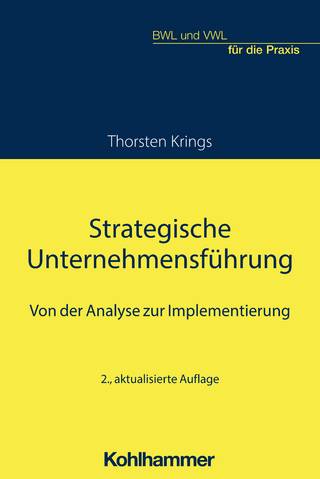
Competitive Inteligence 2.0
ISTE Ltd and John Wiley & Sons Inc (Verlag)
978-1-84821-305-0 (ISBN)
- Titel z.Zt. nicht lieferbar
- Versandkostenfrei innerhalb Deutschlands
- Auch auf Rechnung
- Verfügbarkeit in der Filiale vor Ort prüfen
- Artikel merken
The recent “concept of 2.0", a consequence of "Web 2.0", discusses the emergence of a new style, emancipated from the Web, which finds applications in all areas of social activity: management, innovation, education , organization, territory, etc.
This book considers the implications of the changing paradigm for competitive, economic and territorial intelligence applied to innovation, value creation and enhancement of territories. Competitive intelligence is therefore in the "2.0" and its values: perpetual beta, user-generated content, social relations, etc., horizontality, a renewed legitimacy.
This book, collecting contributions from international experts, testifies to the heterogeneity and richness of possible approaches. It provides a totally new way of evaluating the impact of 2.0 with concrete examples, while analyzing the theoretical models allowing the reader to develop in other contexts the described cases of success.
Luc Quoniam is a university professor, a member of the Paragraphe Laboratory University Paris 8 in France, and leader of the Lab4U Research Laboratory in Science of Information and Communication 2.0.
Foreword xiii
Zhouying JIN
Introduction xv
Luc QUONIAM
PART ONE: Organization 1
Chapter 1. Competitive Intelligence 2.0:
A Three-Dimensional Relationship? 3
Philippe KISLIN
1.1. Introduction: From information society boom 3
1.2. … to the emergence of competitive intelligence 5
1.3. CI perceived as a way of managing relationships 8
1.4. Decision-maker – watcher – information triangle: Toward a “bermudization” of actors? 11
1.5. Teaching companies to be “intelligent”: competitive versus competition? 15
1.6. Conclusion 17
1.7. Bibliography 19
Chapter 2. Management 2.0 23
Miguel ROMBERT TRIGO, João CASQUEIRA CARDOSO and Bruno Filipe CARVALHO SOARES
2.1. Introduction 23
2.2. Competitive environment of the 21st Century 24
2.3. Management 2.0: the world is flat, but organizations should be full 34
2.4. Conclusion 42
2.5. Bibliography 42
Chapter 3. Sustainable Development 2.0: Seeking “The Creation of Shared Values” 45
Fabrice MAULEON
3.1. Introduction 45
3.2. Common features of a new paradigm of 2.0 compliant organizational management 47
3.3. The outlines of Sustainable Development 2.0 56
3.4. Conclusion 68
3.5. Bibliography 69
Chapter 4. Corporate Education and Web 2.0 73
Miguel ROMBERT TRIGO, Alice Maria SALGADO GONÇALVES and João CASQUEIRA CARDOSO
4.1. Introduction: what is corporate education? 73
4.2. Evolution of corporate education 76
4.3. Corporate Education 2.0 79
4.4. Good examples of Corporate Education 2.0 84
4.5. Competitive Intelligence and Corporate Education 2.0 88
4.6. Conclusion 89
4.7. Bibliography 89
Chapter 5. Marketing 2.0 93
Sébastien BRUYÈRE
5.1. Introduction 93
5.2. E-marketing: a changing activity 93
5.3. Web Analytics: an essential discipline for an effective e-marketing piloting 98
5.4. Conclusion 110
5.5. Bibliography 111
PART TWO: Innovation 117
Chapter 6. Parallax: Mindset 2.0 119
Patricia DUPIN
6.1. Introduction 119
6.2. Thought and action in the digital age 119
6.3. Talent for economic intelligence 126
6.4. Final considerations 135
6.5. Bibliography 136
Chapter 7. Competitive Intelligence 2.0 Tools 139
Christophe DESCHAMPS
7.1. Introduction 139
7.2. The impact of 2.0 tools on the deployment of competitive intelligence in business 140
7.3. Typology of 2.0 technologies for competitive intelligence 148
7.4. Perspectives of Competitive Intelligence 2.0 156
7.5. Conclusion 158
7.6. Bibliography 159
Chapter 8. Patent Information 2.0, Technology Transfer, and Resource Development 161
Henri DOU
8.1. Introduction161
8.2. Methodology 162
8.3. International patent classification 163
8.4. A systematic analysis 164
8.5. Search strategies for establishing the initial corpus 167
8.6. Interpretation of results 169
8.7. More precise choices from selected patent 171
8.8. Generalization of the method 173
8.9. Conclusion 177
8.10. Bibliography 178
Chapter 9. Industrial Property: Competitive Weapon 2.0 (Case Study of Tenofovir) 179
Wanise BARROSO and Joachim QUEYRAS
9.1. Introduction179
9.2. Current status of the subject in the international context 181
9.3. Research and results on Tenofovir 183
9.4. Results 187
9.5. Conclusion 188
9.6. Bibliography 191
Chapter 10. Innovation, Serendipity 2.0, Filing Patents from Biomedical Literature Exploration 195
Jean-Dominique PIERRET and Fabrizio DOLFI
10.1. Introduction 195
10.2. The work of Don Swanson 197
10.3. Diseases-Physiopathology-Molecules (DPM) 201
10.4. Conclusion: the place of LBD today 208
10.5. Acknowledgment 213
10.6. Bibliography 213
Chapter 11. Processing Business News for Detecting Firms’ Global Networking Strategies 219
Brigitte GAY
11.1. Introduction 219
11.2. A strong trend: Webs of transactions 221
11.3. Leveraging Web 2.0 for analysis of global interfirm trade 224
11.4. Companies: “open” but “caught in the Web” 227
11.5. Conclusion 236
11.6. Bibliography 238
Chapter 12. Information Property and Liability in the 2.0? 241
Arnaud LUCIEN
12.1. Introduction 241
12.2. Information Property 2.0: questioning authors’ status 244
12.3. Personal information property: considering the topic in the light of 2.0 250
12.4. Publishing Activity 2.0: liability and information 253
12.5. Conclusion 257
12.6. Bibliography 258
PART THREE: Territory 261
Chapter 13. Territory and Organizational Reputation 2.0 263
Serge CHAUDY and Lucia GRANGET
13.1. Introduction 263
13.2. Communication strategies of organizations in the 2.0 concept 265
13.3. Promotion of the territories 272
13.4. Conclusion 281
13.5. Bibliography 282
Chapter 14. Triple Helix and Territorial Intelligence 2.0 285
Rosana PAULUCI
14.1. Evolution in the 2.0 world 285
14.2. Knowledge, innovation, and development 286
14.3. The ST&I systems for Brazilian intelligence 288
14.4. Innovation Portal, the observatory for strategic intelligence 294
14.5. The strategic intelligence system of the Innovation Portal (SISIP): a tool for the Brazilian government 300
14.6. Conclusion 312
14.7. Bibliography 312
Chapter 15. Regional Development 2.0 315
Henri DOU
15.1. Introduction 315
15.2. Definition of Competitive Intelligence 316
15.3. Innovation 317
15.4. An introductory example: South Korea 321
15.5. Other examples of cluster development 324
15.6. The “pre-clustering” in developing countries 327
15.7. Conclusion 330
15.8. Bibliography 331
Chapter 16. Government Strategies of Territorial Intelligence 2.0: Support to SMEs-TPE 333
Kira TARAPANOFF, José RINCON FERREIRA, and Lillian AlVARES
16.1. Introduction 333
16.2. Elements of the 2.0 concept applied to the TIN network 334
16.3. Social and economic impact of the TIN network: some indicators 346
16.4. Telecenters and competitive intelligence: The future of Innovation 2.0 348
16.5. Bibliography 349
Chapter 17. University: Catalyst for the Implementation of Competitive Intelligence 2.0 in Africa (Case Study of Nigeria) 351
Amos DAVID
17.1. Introduction 351
17.2. Genesis of the introduction of EI in Nigeria 352
17.3. Participation in international projects 356
17.4. Economic intelligence: a developmental perspective for Nigeria 359
17.5. Bibliography 360
List of Authors 363
Index 367
| Verlagsort | London |
|---|---|
| Sprache | englisch |
| Maße | 160 x 236 mm |
| Gewicht | 680 g |
| Themenwelt | Technik ► Elektrotechnik / Energietechnik |
| Wirtschaft ► Betriebswirtschaft / Management ► Unternehmensführung / Management | |
| ISBN-10 | 1-84821-305-0 / 1848213050 |
| ISBN-13 | 978-1-84821-305-0 / 9781848213050 |
| Zustand | Neuware |
| Haben Sie eine Frage zum Produkt? |
aus dem Bereich


